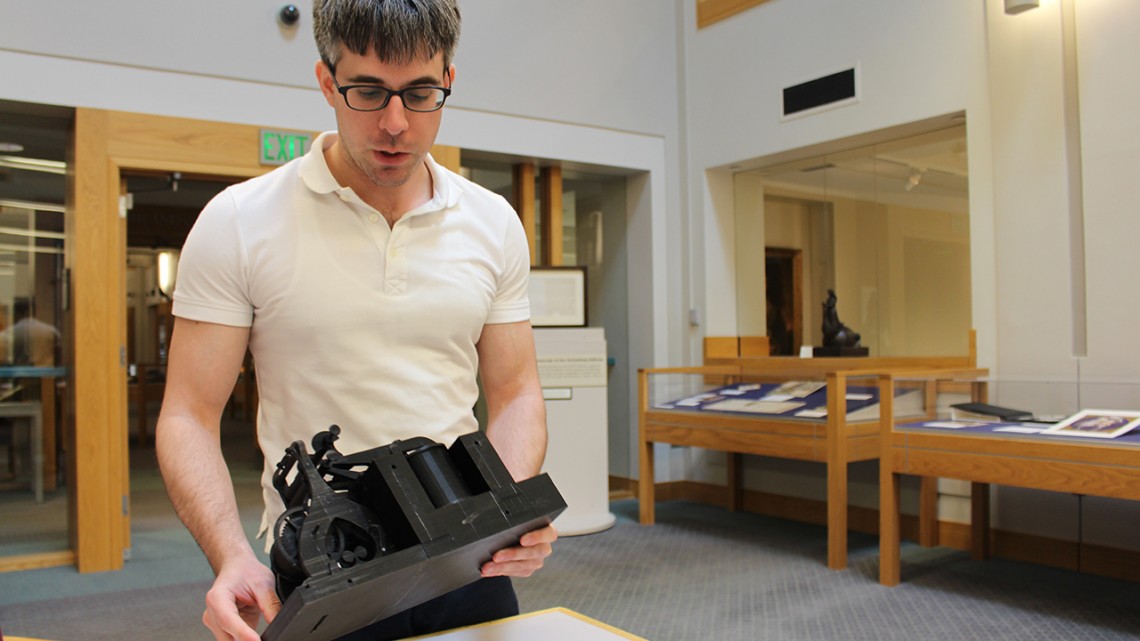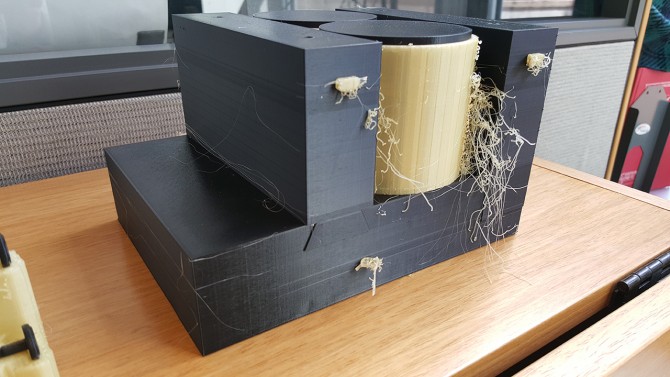
Peter Corina, reference specialist and reproductions coordinator in the Division of Rare and Manuscript Collections, holds the 3D-printed model of the 1844 telegraph.
3D printed telegraph matches Cornell’s original, down to the screws
By Melanie Lefkowitz
Cornell’s 1844 telegraph, which received the world’s first telegraph message and which Ezra Cornell helped develop, is an essential piece of university history.
Even a working replica of that telegraph, created in 2009 by a group of engineering students using Solid Freeform Fabrication, has become an important historical item in its own right.
Both telegraphs help tell Cornell’s story, but both were deemed too valuable and fragile to display at the new Martin Y. Tang Welcome Center. So staff at Cornell University Library did the next best thing: They 3D printed a new model.
“Cornell was about being innovative when it was founded, and the 3D model shows how Cornell continues to be an innovator and a leader. It’s the perfect balance between old and new,” said University Archivist Evan Earle ’02, M.S. ’14.
Peter Corina, reference specialist and reproductions coordinator in the Division of Rare and Manuscript Collections (RMC) by day and a 3D artist and filmmaker by night, volunteered to create the new, detailed model of the telegraph for the welcome center using the library’s makerspace.
The new reproduction of the telegraph took 10 straight days to print in mannUfactory, in Mann Library. James McKee, Mann’s makerspace coordinator, helped Corina develop a plan to print the telegraph in three separate parts, giving them more control and a more seamless finished product.
Once completed, the new version mirrored the 1844 telegraph down to each individual screw.
“It’s to scale, as close as I could get it with hundreds of iPhone pictures and a ruler,” Corina said. “I didn’t think I’d get to mesh what I do after work with what I do at work – it’s pretty awesome.”
The telegraph, purchased for Cornell by the estate of Hiram Sibley, one of the university’s original trustees and earliest benefactors, received the world’s first telegraph message, “What hath God wrought,” sent by Samuel Morse on May 24, 1844.
According to letters recently acquired by RMC, the owner of the telegraph, Stephen Vail, whose father, Alfred Vail, partnered with Morse to invent the telegraph, sold the device to Sibley for $1,000, even though other potential buyers would have paid far more, “in view of the intimate connection of its founder, Mr.Cornell, with the construction of the first line of telegraph.”
“[H]e having been the contractor by whom it was built and the prominence accorded the science of electricity by the University he founded, it is the most fitting place for the final and permanentrepository of this instrument,” Vail wrote.
The letters, as well as a news clipping about the sale, will now be preserved as part of the University Archives in RMC.
“It’s pretty special to have these letters documenting such a significant part of Cornell history,” Earle said.
Melanie Lefkowitz is staff writer, editor and social media coordinator for Cornell University Library.
Media Contact
Get Cornell news delivered right to your inbox.
Subscribe

